Looking for fun doodle ideas? Try silly animal characters with wild faces, funky monster mashups, or adorable UFOs! Go for bursting patterns with swirling flowers, or mix up dreamy clouds and food with big personalities (who wouldn’t love a dancing donut?). Surreal objects, retro paisley doodles, and playful gadget sketches can twist reality in creative ways. Even basic shapes or monogram initials can become works of art. The next set of ideas packs even more imagination and surprises!
Key Takeaways
- Combine whimsical animals or funky monster mashups to spark imagination and playful storytelling in your doodles.
- Create bold, abstract botanical patterns or expansive floral wreaths to explore nature-inspired artistry.
- Illustrate quirky food characters or surreal object mashups to add humor and visual interest.
- Experiment with retro doodle patterns using flat colors, bold outlines, and repeating shapes for a vintage feel.
- Personalize designs with artistic monogram initials or sketch famous travel landmarks for unique, meaningful artwork.
Whimsical Animal Characters
Whimsy takes center stage when it comes to drawing animal characters that practically dance off the page with personality. In doodle art, whimsical animal characters are bursting with silly charm—think bunnies with oversize grins, or cats rocking giant sunglasses.
Artists love to experiment with exaggerated features and playful expressions, pumping life and humor into each drawing. By splashing on vibrant colors and adding unexpected accessories (like a fox wearing a polka-dot bowtie), they create creatures that feel both magical and relatable.
Some doodles keep things simple and cartoon-like, while others explore funky shapes and intricate patterns, building excitement with every detail. These critters often become instant story starters, letting anyone imagine wild adventures or giggle at their goofy charm.
Doodle art never looked so joyful!
Abstract Botanical Patterns
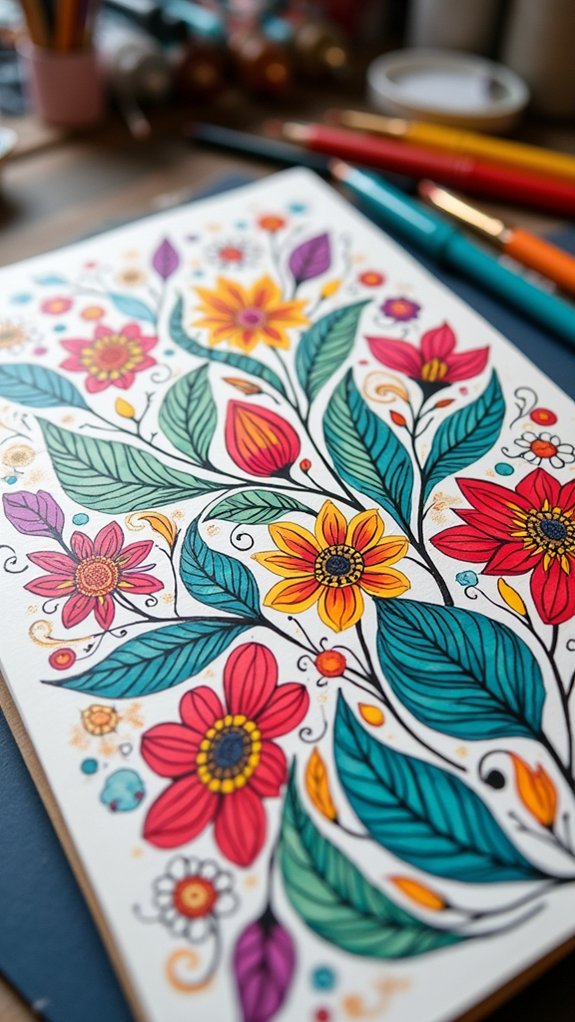
Even though they don’t always look like real plants, abstract botanical patterns are seriously eye-catching—almost like a garden dreamed up by someone with a wild imagination and a box of neon markers.
These designs come alive with swirly shapes, wavy lines, and explosions of color that can make anyone’s notebook pop. It doesn’t matter if you can’t tell your ferns from your ficus—make sure you have fun with it when you draw one!
Try layering shapes, mixing in gradients, or leaving blank spaces to add cool texture and depth. Artists love experimenting with watercolors, markers, or digital tools to see what wild combos work best.
Doodling these patterns isn’t just creative—it’s a great way to relax and let your imagination run absolutely wild.
Playful Food Illustrations
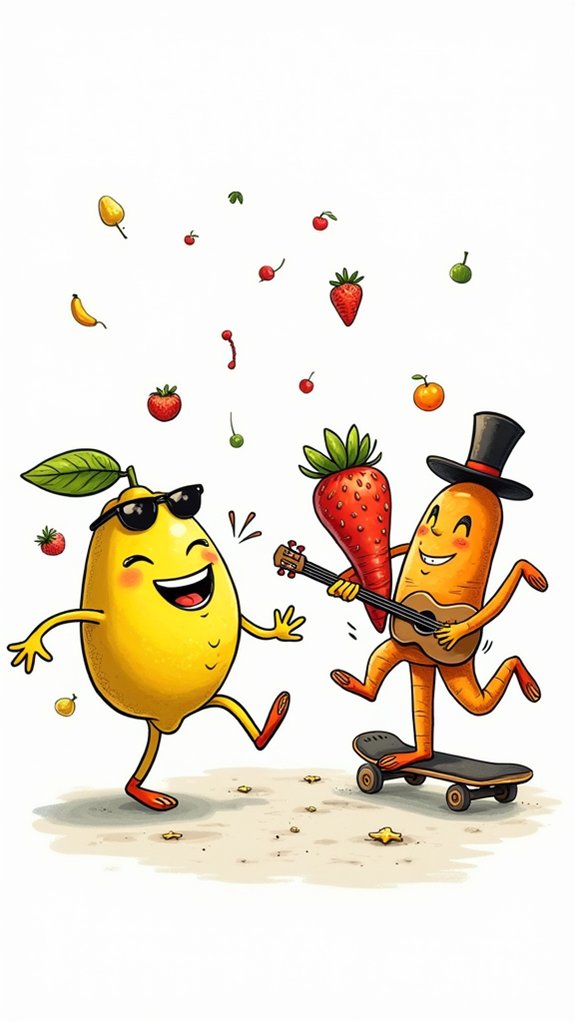
Swirling lines and wild colors aren’t just for imaginary plants—food can get in on the fun too! Playful food illustrations let artists blend food character mashups with silly faces, hats, and dancing poses. A smiling taco, a broccoli superhero, or a pizza cat—there are no limits when imagination leads the way.
Artists immerse themselves in vibrant color experiments, making fruits pop and veggies look even more delicious than in real life. Clever culinary pun illustrations (like a “breadwinner” loaf holding a trophy) can spark laughs, and these doodles often find their way onto recipe books or social media feeds. Mixing in exaggerated shapes, bold outlines, and hilarious settings transforms basic snacks into artful masterpieces.
- Dancing doughnuts party scene
- Avocado superhero squad
- Sushi roll animal mashups
- “Pun-derful” veggie jokes
Op-Art Inspired Spirals
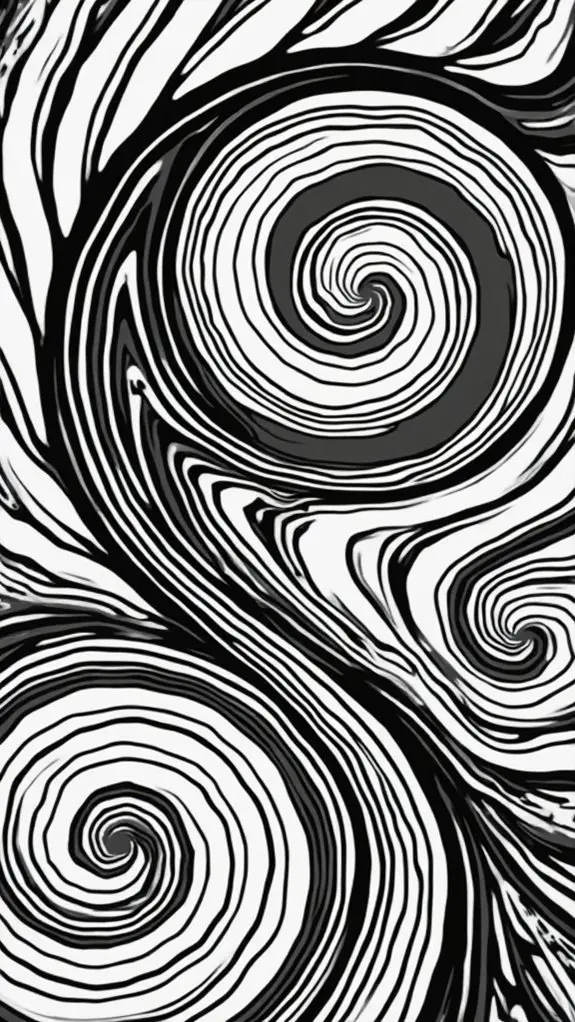
Hypnotic patterns take center stage with Op-Art inspired spirals, turning a plain sheet of paper into a spinning illusion of motion.
These spirals start with just a single dot, but before you know it, you’re whipping up lines and upside-down “u” shapes that seem to swirl right off the page.
Spiral color exploration is key—try swapping out colors for every section to make your art pop! Adding line thickness variations ups the wow factor, fooling your eyes into seeing greater depth.
It’s kind of like sneaking in a magic trick, but with pens and markers instead of a top hat.
With a few depth perception tricks, each doodle becomes a wild, dizzying playground for your imagination—no secret decoder ring required!
Nature Transformations
Once minds have spun through the wild, eye-bending world of Op-Art spirals, it’s time to catch a breath and stroll into the endless playground that nature offers.
Doodle art shines when it taps into nature symbolism, tracing the growth journey from muddy roots to vibrant blooms. Nature transformations in doodles aren’t just pretty—they’re powerful reminders of resilience.
Sketching mountains, twisting rivers, and the slow transformation of seasons sparks seasonal reflections, reminding artists how cool change can be.
Whether drawing a brave little plant pushing through the soil or layering a ring of flowers in a botanical wreath, creativity flourishes. It’s like doodling a pep talk from the earth itself.
- Flowers rising from mud to bloom
- Changing trees for each season
- Mountain and river scene outlines
- Whimsical botanical wreaths
Quirky Hand-Lettered Quotes
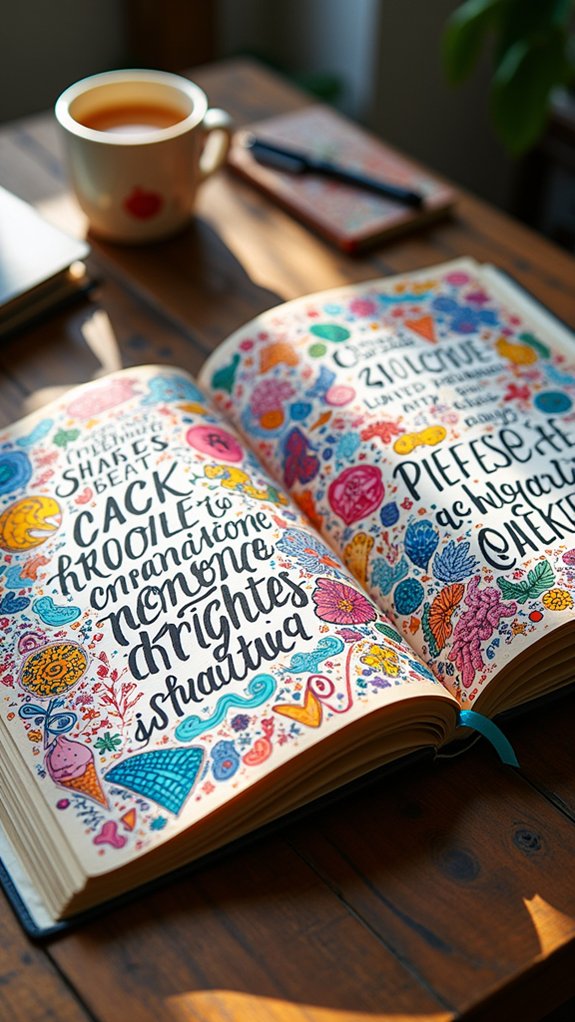
Even when a page feels a little empty, quirky hand-lettered quotes can swoop in to save the day—kind of like a superhero with a bunch of fancy pens!
These fun additions mix playful phrases with artistic typography, instantly giving doodle art a personal touch that’s hard to miss. Artists love to play with different lettering styles, like using block letters that shout or brush lettering that flows.
Sometimes, they even add wild colors, patterns, or doodly borders to make each word pop off the page. Whether the message is inspiring, silly, or encouraging, hand-lettered quotes let creators share a bit of themselves.
They’re popular everywhere—on bullet journals, wall décor, and all over social media, sparking friendly inspiration from one doodler to another.
Cityscape Silhouettes
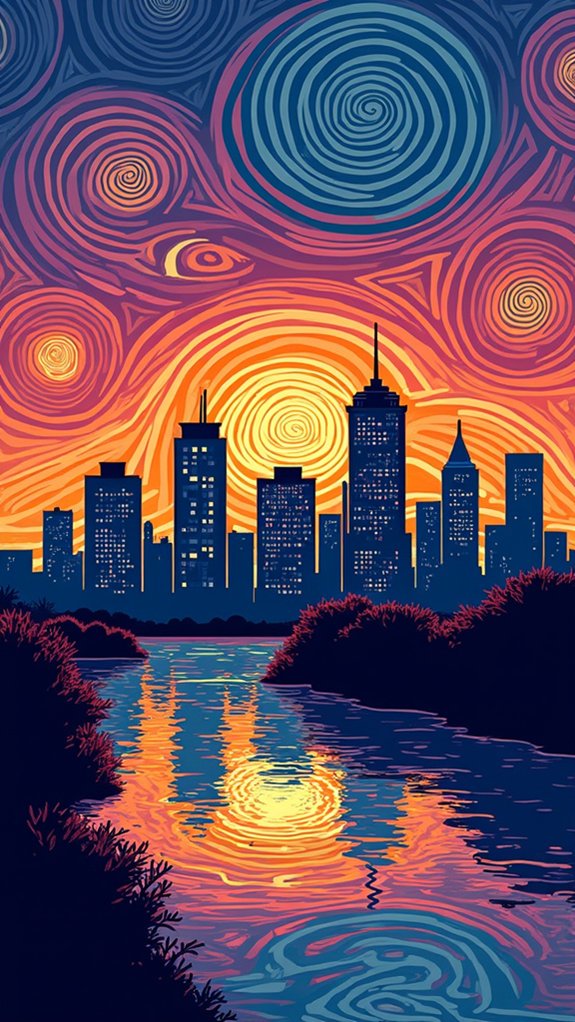
Cityscape silhouettes are like snapshots of a city’s coolest shapes, and artists have all sorts of tricks to make those skylines pop. Some play with how the buildings line up, stacking tall skyscrapers next to tiny rooftops, while others create a moody nighttime look with glowing windows or a sky full of stars—talk about magic after dark!
Whether it’s a wild tangle of bridges or a few bold lines, building your own cityscape is a fun mix of planning and letting your imagination cruise around town.
Skyline Composition Techniques
- Cloud-filled skies
- Unique rooftops
- Contrasting sunsets
- Playful negative space
Nighttime Silhouette Effects
How can a few bold lines turn an ordinary city into something as mysterious as midnight? That’s the magic of urban nightscapes drawn with silhouette techniques!
Start by sketching the city’s outline with sharp, confident lines. Fill the sky behind with a deep gradient of blues, purples, or jet-black—suddenly, everything feels dramatic, like a secret is hiding behind every window.
Want to level up the nighttime atmosphere? Pop in some twinkling stars, a sneaky crescent moon, or maybe a glowing streetlamp for extra flair.
Play around with building shapes and heights, or layer them to add depth, like skyscraper lasagna! Using thicker or thinner lines makes those buildings stand out or melt into the shadows.
Who knew cities could look this cool after dark?
Dreamy Galaxy and Space Themes
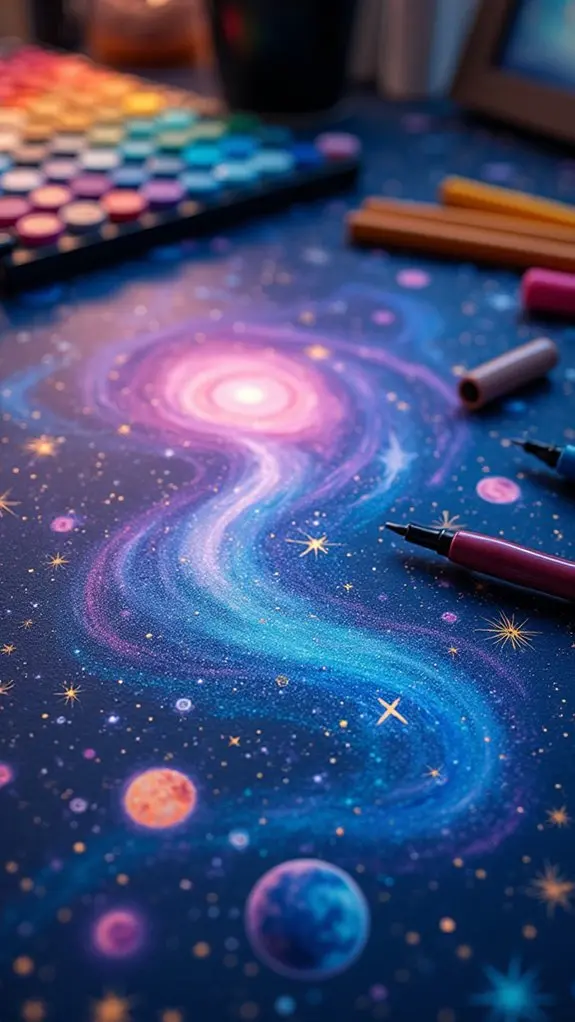
When it comes to dreamy galaxy and space doodles, there’s nothing cooler than filling your page with swirling planets, glowing moons, and crazy cosmic patterns.
Drawing clusters of sparkling stars, quirky UFOs, or even the occasional bug-eyed alien can make your artwork feel like it’s straight out of another universe—no spaceship required.
With every sketch, artists get a chance to imagine wild new worlds and maybe even trick a friend into believing they’ve spotted actual space cheese!
Cosmic Planets and Moons
Space is like the ultimate doodle playground, where imagination gets to blast off into wild, dreamy galaxies filled with planets, moons, and stars.
When it comes to cosmic planets and moons, doodlers can play with colorful nebula designs—those swirly, magical clouds that basically scream, “Look at me, I’m from outer space!”
Drawing planets isn’t just about circles; add wild planetary surface textures with craters, dots, and wavy lines for that true space vibe.
Explore lunar phases using different shades and patterns, because moons change their “look” like they’re at a cosmic fashion show.
Throw in sparkling backgrounds and shooting comets if you want people staring at your art like it’s from another world.
- Swirled colorful nebula designs
- Textured planetary surfaces
- Lunar phases exploration
- Starry, dotted backgrounds
Whimsical Star Patterns
Starlight might just be the ultimate magic ingredient for transforming any doodle into a galaxy of pure awesome. Just imagine filling a page with whimsical star patterns—tiny five-pointed stars, shooting stars racing across the paper, and twinkling dots that look like a real starry night dropped onto your notebook!
By mixing in some swirling cosmic wonders, a happy moon, or a cartoonish planet with a grin, the doodle becomes a playground for celestial designs. Add blasts of purple, blue, or a dash of metallic for extra sparkle, making the stars pop like confetti.
Whether someone connects the dots into wacky constellations or repeats star shapes for a super unique vibe, these star patterns bring tons of visual magic—no rocket required!
UFOs and Alien Motifs
Aliens and UFOs are basically the official mascots of all things weird and wonderful in outer space. When it comes to doodling, nothing sparks the imagination quite like alien encounters or zipping around on cosmic travel adventures.
UFO and alien motifs let artists play with crazy, vibrant colors and wild shapes—think saucer spaceships with glowing beams or cheeky aliens with big eyes and wiggly antennas.
Top it off with a dreamy galaxy full of stars and planets in the background, and you’ve got some seriously cool extraterrestrial art. People love these themes because they let your mind wander into the unknown, where creativity has no rules.
- Saucer-shaped UFOs with glowing lights
- Cute aliens peeking out, waving hello
- Swirling galaxy backgrounds with sparkling stars
- Aliens with fun, cartoony expressions
Doodle Borders and Frames
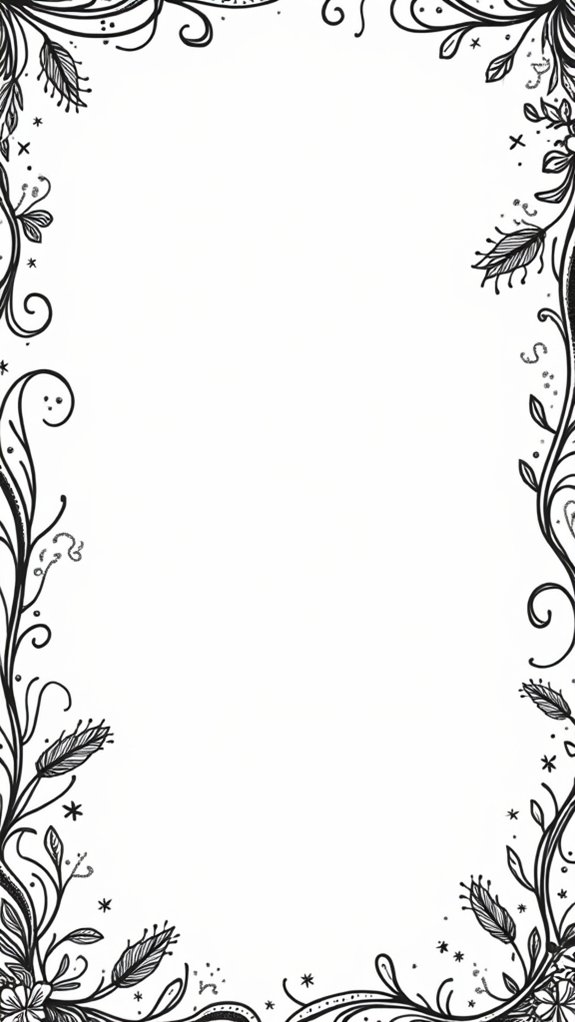
Lots of people find that doodle borders and frames can totally change the look of a page, giving boring edges some serious personality and making the center really stand out.
When it comes to doodle border techniques, there are so many ways to get creative—think waves, spirals, even cute floral lines dancing around the edge.
For those hunting for creative frame ideas, experimenting with thick and thin lines or adding bursts of color can make your whole space pop.
Personalized border styles might feature your initials, favorite symbols, or funky patterns that show off your style.
Doodle borders aren’t just for art, either! They can help organize info in journals, make headings less blah, or simply bring everything together in a super fun way.
Funky Monster Mashups
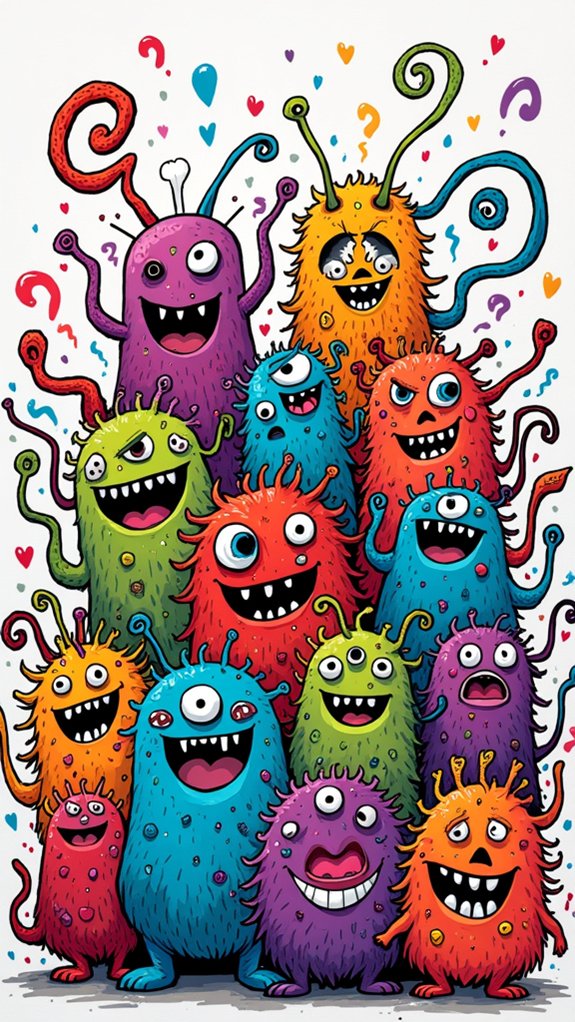
Funky monster mashups are all about mixing creature features, like giving a dragon bunny ears or combining an octopus with a unicorn horn—seriously, the weirder the better!
Artists can get wild by putting arms, legs, or wings in unexpected places, so a monster might have six hands waving from its tummy or eyes peeking out from its knees.
This playful way of experimenting lets every monster turn out totally one-of-a-kind, full of surprises and plenty of laughs along the way.
Mixing Creature Features
Monster mashups are where creativity gets to run wild, like a party where every creature in the universe is invited. Mixing creature features is all about trying out wild ideas—think dragon tails on bunny bodies, or maybe a shark with butterfly wings.
It’s a chance to make imaginative hybrids that nobody’s ever seen before, with totally whimsical features that might surprise even the artist! No need to stick to real life—if you want a cactus-cat or a disco-ball dinosaur, go for it. Bold colors and playful patterns just make these doodles pop, adding even more fun to the mix.
Here are a few creature combinations you might want to try:
- Octopus arms with owl eyes
- Elephant trunk on a penguin
- Leopard spots on a flamingo
- Robo-crab claws with fairy wings
Experimenting With Limb Placement
Once the wildest critter combo ideas start bubbling up, it’s time to get creative with where all those arms, legs, wings, and tentacles go.
Think about it: why settle for two boring feet when your goofy monster could rock four? Limb variations open up a whole playground for character dynamics.
Try switching out a bird wing for a squid tentacle, or slap a giant crab pincer right where a human arm would go—suddenly, your creatures have a story all their own!
Playful configurations bring energy and tons of personality. Don’t be afraid to sketch a bunch of silly options before you pick your favorite.
Colorful stripes or polka-dotted knees crank up the fun. Who knows, maybe three left hands are just what your monster needed!
Travel Landmarks Sketches
There’s something seriously exciting about grabbing a sketchbook and trying to capture famous travel landmarks, like the towering Eiffel Tower or the ancient Colosseum.
Sketching these places isn’t just about copying buildings—it’s an adventure in landmark interpretations, mixing in cultural context, and showing off cool artistic techniques.
Maybe one person sees the Statue of Liberty as bold and windswept, while another doodles playful pigeons floating around Big Ben. Adding background details can really bump up a sketch’s story power, making every drawing more than just “look, it’s a building.”
Different pencils, watercolors, or even digital tools let everyone explore their signature style. Each sketch becomes a postcard of memories—no postage required!
- Paris’s Eiffel Tower with city lights
- Rome’s Colosseum from a sunny park
- Sydney Opera House reflected in water
- Great Wall twisting through mountains
Comic Strip Storytelling
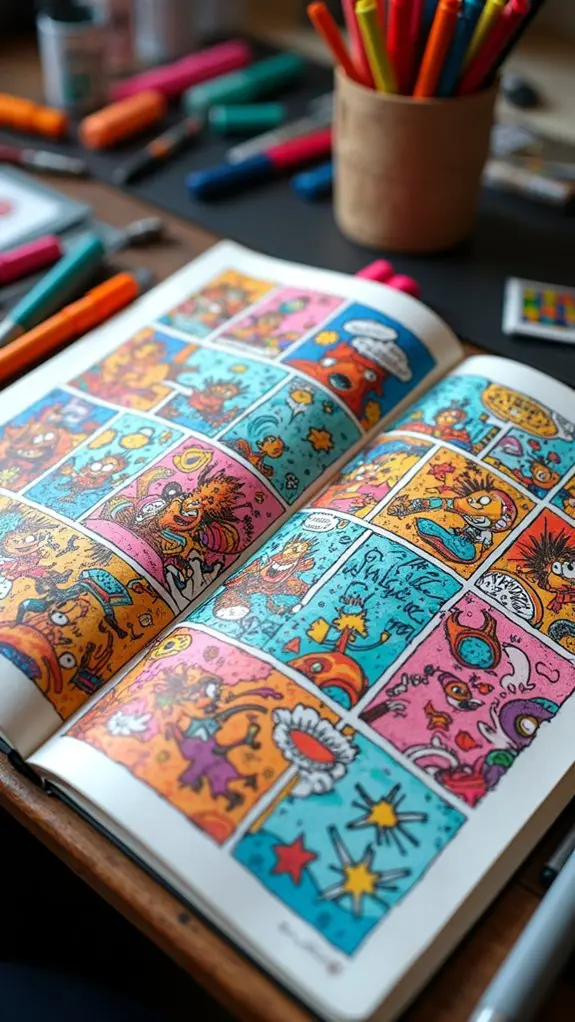
Comic strip storytelling really comes alive when artists play around with character expressions, mixing big grins, wild eyebrows, or eye-popping surprise to show every emotion under the sun.
Switching up panel layouts—like tossing in a long, skinny panel for suspense, or stacking a bunch of tiny ones for fast action—keeps readers guessing what’s next.
Character Expressions and Emotions
Emotion steals the spotlight when it comes to doodling characters in comic strips—every raised eyebrow, crooked grin, or even a wild hair flip can change the whole mood of a scene.
Diving into character emotions analysis helps artists capture those awesome feelings, whether it’s joy, shock, or total meltdown vibes. Expressive color palettes really pump up those emotions—think hot reds for anger or cool blues for chill-out moments.
Visual storytelling techniques, like dramatic body language and intense facial expressions, let readers “feel” the scene without reading a single word. And don’t forget speech bubbles and wild sound effects—they add just the right oomph!
- Over-the-top facial expressions for clear emotion
- Bright, contrasting colors for mood
- Dramatic poses and gestures
- Speech bubbles and sound effects for emphasis
Panel Layout Variety
Switching up the way panels are laid out on a comic strip page can totally change the vibe of a story. Instead of sticking to boring old grids, artists use panel shape experimentation and clever panel arrangement strategies to make the story really pop.
Sometimes, there are huge splash panels or weird, jagged ones that break out of the box—literally! These dynamic storytelling techniques help the action feel faster or the mood more intense. Overlapping panels can make it look like things are crashing together or racing by.
Even where speech bubbles and captions go can mess with how readers see the story, so it’s all about balance. Basically, panel layouts aren’t just boxes—they’re tools for wild creativity!
Visual Pacing Techniques
Every great comic strip has its own special rhythm, and that’s where visual pacing techniques come in. The way artists arrange panels shapes how you experience a story—fast, slow, or with a dramatic twist!
Visual rhythm techniques mean changing up panel sizes: big ones shout “pay attention!” while small ones zoom the story along like a chase scene. Panel shift strategies help you follow the action without getting lost; think action-to-action jumps or swapping scenes in a flash.
For extra punch, dynamic storytelling elements like motion lines or bold faces stir up energy and emotion. Done well, these choices can make you laugh harder or gasp in suspense.
Here are some ways creators use visual pacing:
- Mix up panel sizes for high or low energy moments
- Use scene transitions for smooth storytelling
- Add motion lines for action
- Draw expressive faces to show big emotions
Personalized Monogram Designs
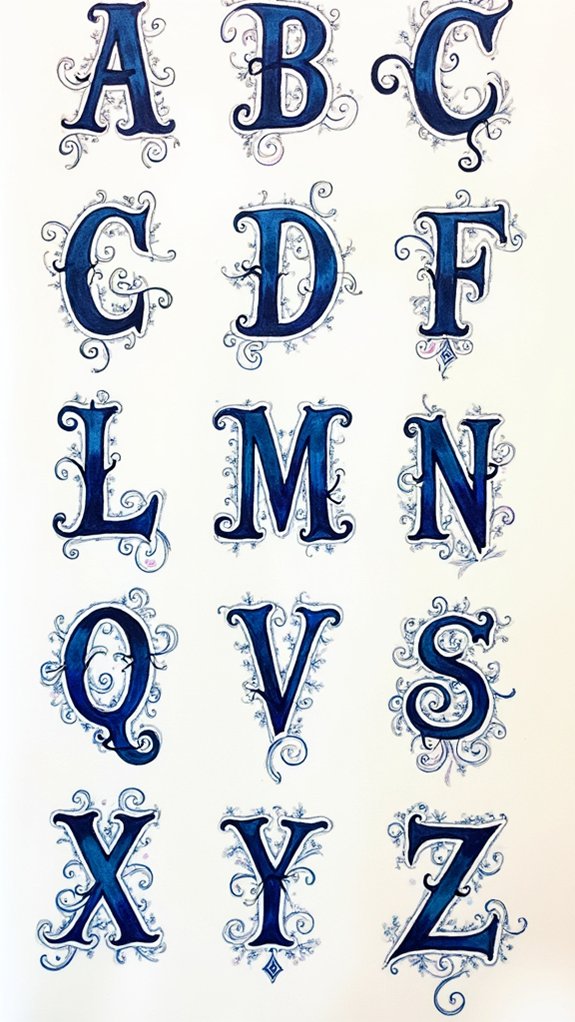
Monograms are like the VIP badges of the doodle world—they take a simple pair (or trio) of initials and turn them into something personal and eye-catching. There’s nothing plain about these artistic signatures; monogram customization techniques let artists mix modern typography styles with funky shapes, swooping lines, or a splash of doodle squiggles.
Throw in artistic color palettes, from soft pastels to bold rainbow explosions, and suddenly those letters come alive! Whether scrawling them by hand or tapping away on digital art tools, creators can go wild—swirling leaves, hidden stars, even geometric lightning bolts.
Personalized monogram designs aren’t just for fancy weddings or stationery; they shout, “Hey, that’s me!” in a way no store-bought sticker ever could.
Seasonal Scene Creations
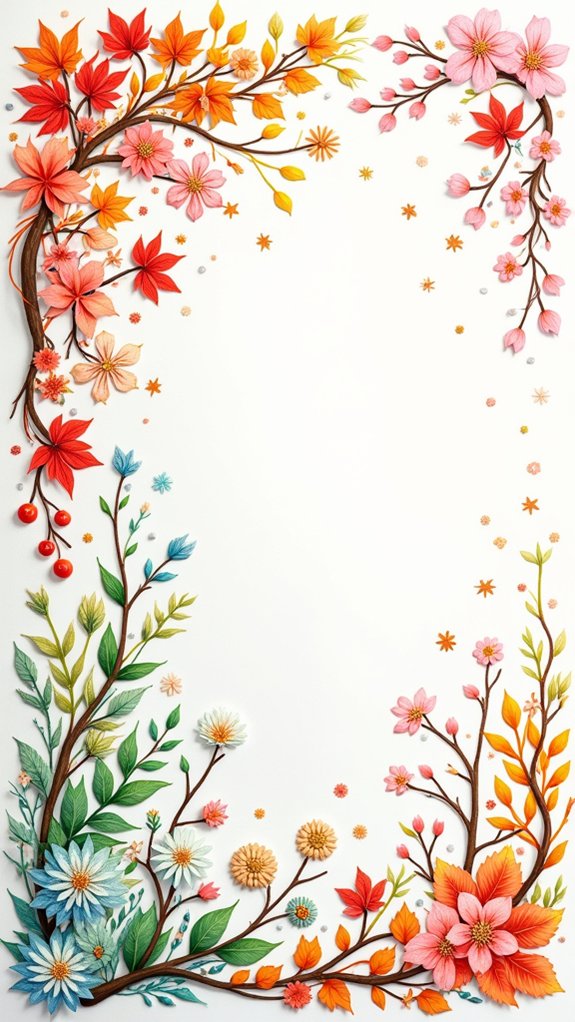
When the seasons change, doodle art can turn everyday moments into mini-adventures, letting artists splash a bit of spring sunshine or winter sparkle right onto the page.
Just think about doodling clusters of spring blooms, a sandy pair of flip-flops washed up on summer beaches, or baskets loaded with autumn harvests.
Even simple things like a pumpkin, sunflower, or the swirl of a snowflake can make a scene pop with seasonal magic.
Playing with the right color for each season—bright for summer, cozy for fall, pastel for spring, icy blue for winter—is like giving your artwork a seasonal wardrobe change.
Plus, trying out new doodle styles for each season keeps things fun and fresh.
- Spring blooms and buzzing bees
- Summer beaches with surfboards
- Autumn harvests and swirling leaves
- Snowy hills with sledders
Geometric Mandalas
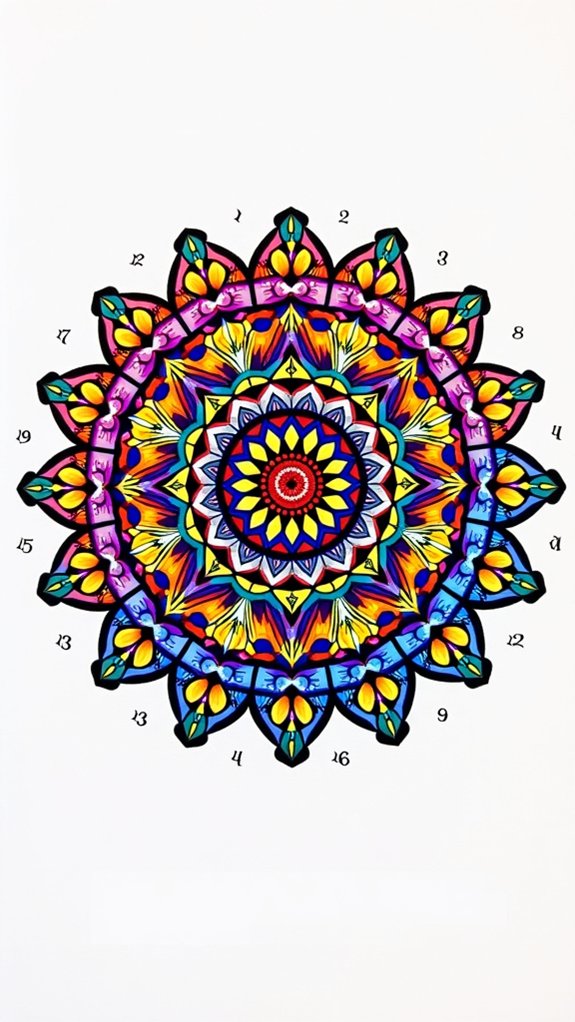
There’s something almost magical about watching a geometric mandala take shape, as simple circles and lines slowly grow into a wild burst of repeating patterns.
These intricate designs use geometric symmetry techniques, so tools like rulers, compasses, and sometimes a steady hand are a must—unless you want your mandala to look like it was drawn on a rollercoaster!
The real fun begins when it’s time to add color. Mandala coloring methods range from subtle shades to neon explosions, and picking your palette sometimes feels as intense as choosing toppings for an epic ice cream sundae.
Drawing geometric mandalas isn’t just about making something beautiful. The mindful doodling practices involved can be super calming, letting artists relax—just like people did in ancient times, only with fewer togas involved.
Underwater Explorations
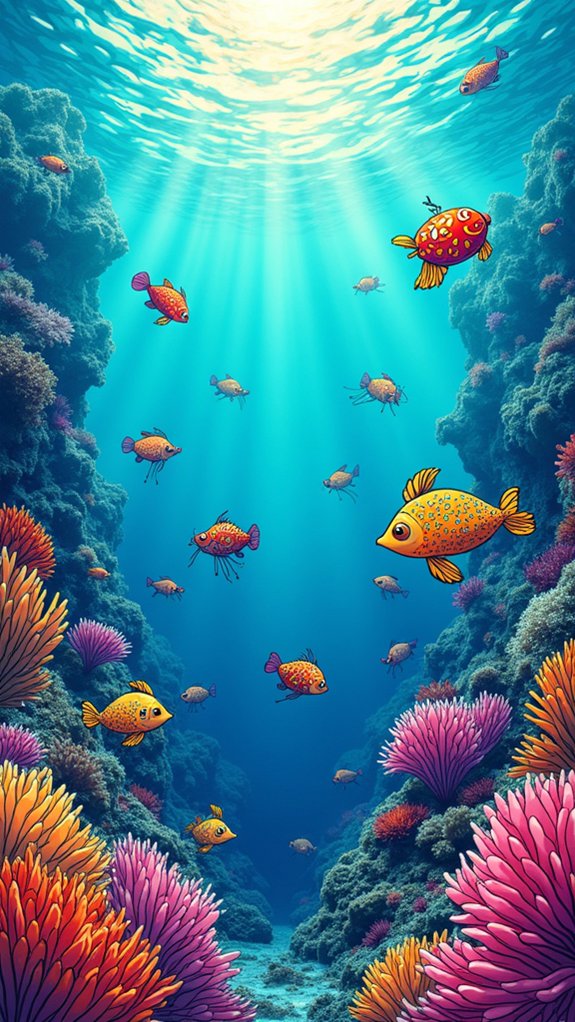
After zipping through the dizzy world of geometric mandalas, some artists might find themselves craving something wilder—like taking a sketchbook and plunging straight into the ocean’s hidden corners.
Imagine sketching spiky coral, shy little fish peeking out, or even a goofy sea turtle dodging a school of jellyfish! Underwater texture exploration turns your doodles into living, breathing sea-views with silky seaweed, shimmering bubbles, and those cool light rays dancing across ocean floors.
Doodlers can let their imaginations run wild, creating imaginative ocean scenes complete with underwater castles and mysterious creatures.
And here’s a bonus: sharing these doodles can spark marine conservation awareness, helping keep oceans magical for real.
- Colorful fish and coral patterns
- Whimsical mermaids and underwater castles
- Bubbling, swirling water textures
- Conservation-themed sea creature doodles
Imaginative Machines and Gadgets
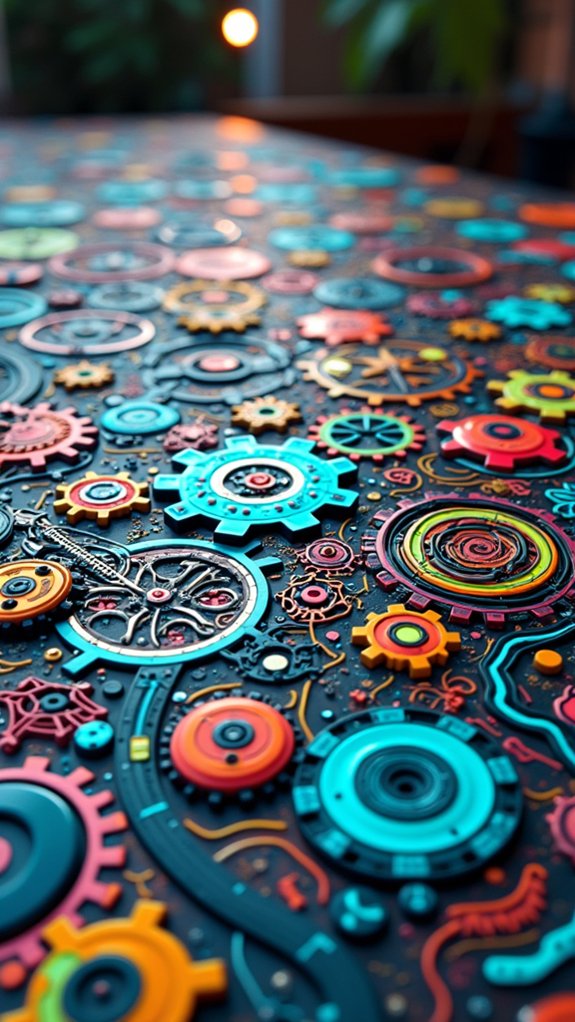
Get ready to let your imagination run wild with doodles of quirky robots, out-of-this-world inventions, and machines that look like they rolled straight out of a steampunk story.
Imagine a robot chef with spaghetti arms or a pocket-sized gadget that does your homework with a wink.
Whether it’s a gadget that waters your plants with a giggle or a clockwork contraption powered by hamster wheels, doodling these imaginative machines is all about having fun and coming up with ideas that make you smile.
Whimsical Robot Creations
Even though robots are often imagined as serious, high-tech machines, turning them into whimsical doodle creations opens up a world of playful possibilities.
These artistic robotic companions can have wild hair made from springs, mismatched legs that wobble, or faces that grin with an extra dose of mischief. Doodlers can have endless fun inventing interactive designs—think robots with arms that spin, or heads that pop up and down like a surprised jack-in-the-box!
Toss in some colorful gadgets, like robots that play tiny drums or sport a teapot on their chest, and every creation gains its own personality.
Want to try? Here are some awesome doodle ideas:
- A robot shaped like a cat, with springy whiskers
- Brightly patterned robot with musical gadget arms
- Goofy bot with rotating eyes and a flower hat
- Friendly cooking robot with spatulas for hands
Futuristic Everyday Inventions
If drawing goofy robots made your imagination go wild, wait until you get a taste of futuristic everyday inventions.
Picture a home where smart home automation just knows when you’re bored and changes your music, or maybe dims the lights for a midnight snack raid—no more tripping over the dog!
Doodle wearable health tech, like bracelets that scan your mood or T-shirts that tell you it’s time for a break.
Why not design a kitchen with a 3D food printer? Imagine pizza in any shape you want—dragon slice, anyone?
There’s also plenty of eco friendly innovations, like solar-powered phone chargers that look like little suns on your window, and tiny, funky water purifiers for your backpack.
The future seriously looks fun—and super convenient!
Steampunk-Inspired Contraptions
While some people dream up sleek, shiny gadgets of the future, others love to mix things up with steampunk—where Victorian vibes and wild imagination collide.
Steampunk doodle art is all about creating wild, imaginative machines that look both old-fashioned and futuristic at once. Think of crazy steampunk gadgets powered by steam and packed with a million gears, or vintage inventions with pipes and clockwork mechanisms that spin and tick.
These drawings often have tons of brass and copper colors, giving a real antique feel while still being totally made up. Some artists dream up airships, robot birds, and even steam-powered skateboards!
Here are a few ideas that pop up in steampunk-inspired contraptions:
- Airships with balloon sails
- Clockwork animals
- Steam-powered bicycles
- Mechanical top hats
Surreal Mixed Objects
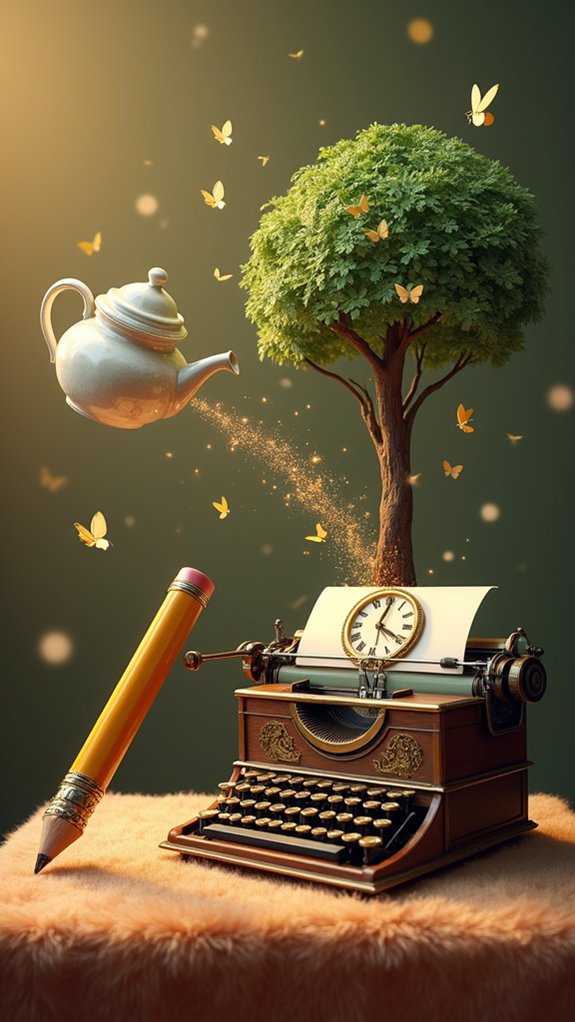
Step right into the wild world of surreal mixed objects, where things get weird—in the coolest way possible. Imagine a fish riding a bicycle through a field of floating alarm clocks—that’s the idea behind surreal object juxtapositions!
In this style of doodle art, everyday items get mashed up with bizarre or dreamlike compositions, and suddenly the ordinary turns extraordinary. Artists love to play with perspectives; maybe a tiny teacup towers over a massive elephant, or clouds drip like melting ice cream.
Want to kick it up a notch? Add imaginative textures and wild patterns, which make everything pop and look even more unreal. Don’t be scared to use bold color contrasts either, because the odder, the better—seriously, anything goes here!
Expansive Floral Wreaths
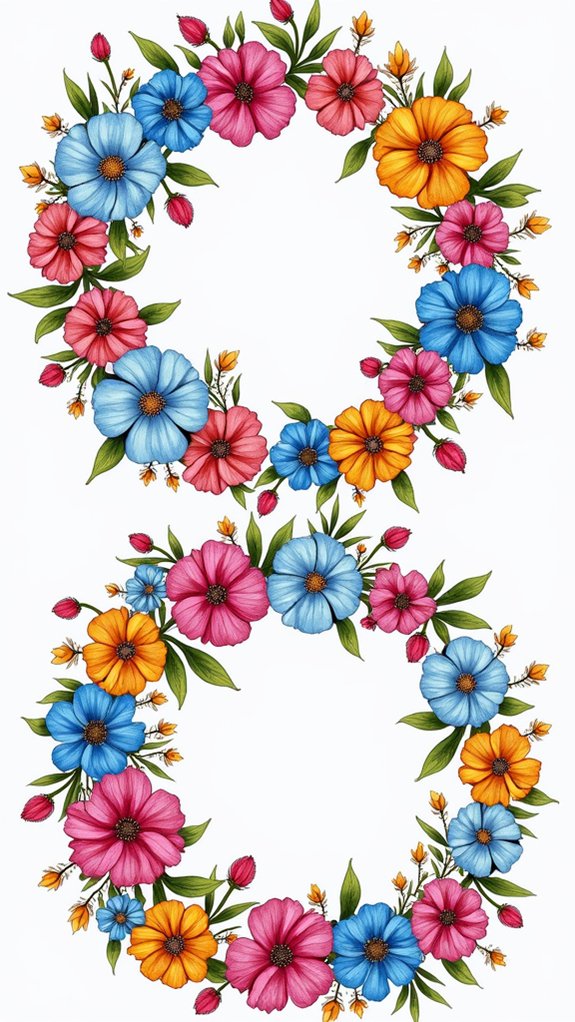
There’s something seriously magical about doodling an expansive floral wreath. It feels like you’re building a secret garden, one petal at a time.
Exploring floral color palettes is half the fun—imagine sunny yellows, moody blues, or cheerful pinks. Wreath composition techniques are all about starting with a simple circle and filling it up with swirling vines, leaves, and seasonal flower selections.
Want springtime cherry blossoms or autumn sunflowers? Totally up to you! Experimenting with different line thickness makes the design pop, adding depth and texture. Templates help a lot, especially when you’re new to drawing these beauties.
Here are some go-to ideas:
- Mix bold and pastel flower colors
- Try overlapping leaves for texture
- Add tiny berries or spirals
- Practice with printable wreath worksheets
Retro Doodle Patterns
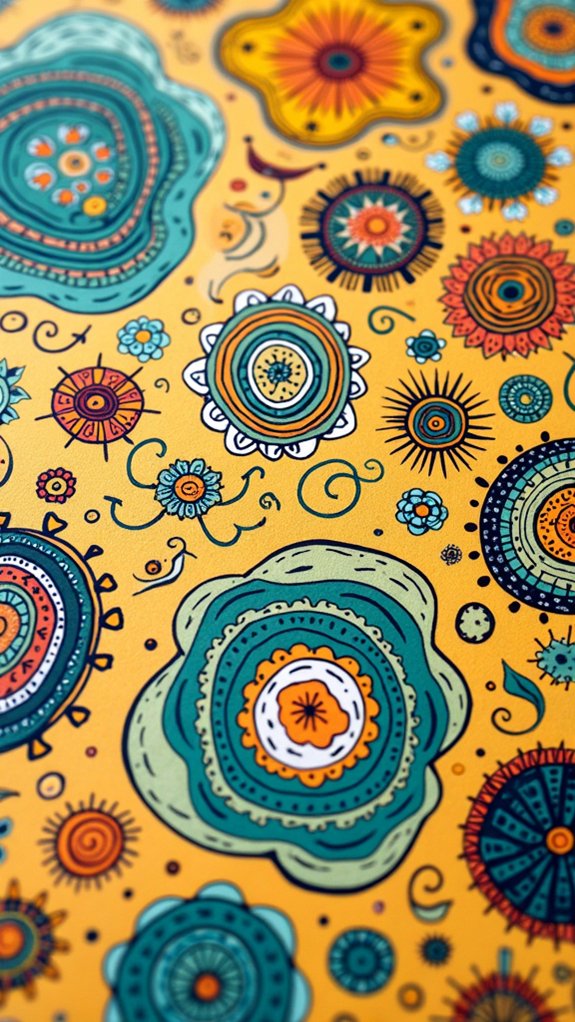
If someone ever wished their sketchbook could time travel, retro doodle patterns would be the ride! These patterns throw artists straight into a world bursting with retro color schemes, wild geometric shapes, and nostalgic motifs that look like they jumped out of a groovy 1970s poster.
Think bold outlines and flat, punchy colors—no shading allowed. Paisley designs swirl next to funky abstract florals and wild psychedelic loops, creating art that’s as playful as disco roller skates.
Artists love repeating patterns for big backgrounds, like fabric prints or funky wallpaper, making their doodles look like they’re dancing. Limiting colors to primaries and pastels keeps everything super retro, while keeping things easy on the eyes.
Retro doodles? Maximum fun, maximum throwback!
Frequently Asked Questions
What Are the Five Styles of Doodling?
When considering the five styles of doodling, one notes abstract designs, geometric patterns, character illustrations, nature themes, and Zentangle techniques. Each style offers a different approach, from structured motifs to organic forms and imaginative compositions.
How to Make a Creative Doodle?
To make a creative doodle, one selects engaging doodle themes, experiments with diverse doodle techniques like varied lines and patterns, and chooses suitable doodle materials. Embracing spontaneity and thoughtful color application further enhances originality and visual appeal.
How to Doodle When Bored?
When bored, one could engage in doodle games, practice mindful drawing, or create spontaneous sketches. These methods help channel restless energy into creativity, offering both relaxation and a fun way to pass the time productively.
What Is Doodle Art for Beginners?
Doodle art for beginners focuses on simple doodle techniques using basic doodle materials such as pens and sketchbooks. New artists can explore various doodle themes, starting with shapes and patterns before advancing to more detailed compositions.
Conclusion
So, there you have it—twenty wild, wacky, and wonderful doodle ideas just waiting for your pen to bring them to life. Whether your notebook is packed with animals wearing hats or groovy patterns that practically move on the page, it’s all about having fun and letting your imagination run wild. Doodling isn’t about being perfect, it’s about being creative. So grab that sketchbook, release your inner weirdo, and let the doodles begin!


Leave a Reply